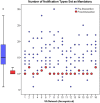Impact of a national QI programme on reducing electronic health record notifications to clinicians
- PMID: 29507122
- PMCID: PMC6365918
- DOI: 10.1136/bmjqs-2017-007447
Impact of a national QI programme on reducing electronic health record notifications to clinicians
Abstract
Background: Emerging evidence suggests electronic health record (EHR)-related information overload is a risk to patient safety. In the US Department of Veterans Affairs (VA), EHR-based 'inbox' notifications originally intended for communicating important clinical information are now cited by 70% of primary care practitioners (PCPs) to be of unmanageable volume. We evaluated the impact of a national, multicomponent, quality improvement (QI) programme to reduce low-value EHR notifications.
Methods: The programme involved three steps: (1) accessing daily PCP notification load data at all 148 facilities operated nationally by the VA; (2) standardising and restricting mandatory notification types at all facilities to a recommended list; and (3) hands-on training for all PCPs on customising and processing notifications more effectively. Designated leaders at each of VA's 18 regional networks led programme implementation using a nationally developed toolkit. Each network supervised technical requirements and data collection, ensuring consistency. Coaching calls and emails allowed the national team to address implementation challenges and monitor effects. We analysed notification load and mandatory notifications preintervention (March 2017) and immediately postintervention (June-July 2017) to assess programme impact.
Results: Median number of mandatory notification types at each facility decreased significantly from 15 (IQR: 13-19) to 10 (IQR: 10-11) preintervention to postintervention, respectively (P<0.001). Mean daily notifications per PCP decreased significantly from 128 (SEM=4) to 116 (SEM=4; P<0.001). Heterogeneity in implementation across sites led to differences in observed programme impact, including potentially beneficial carryover effects.
Conclusions: Based on prior estimates on time to process notifications, a national QI programme potentially saved 1.5 hours per week per PCP to enable higher value work. The number of daily notifications remained high, suggesting the need for additional multifaceted interventions and protected clinical time to help manage them. Nevertheless, our project suggests feasibility of using large-scale 'de-implementation' interventions to reduce unintended safety or efficiency consequences of well-intended electronic communication systems.
Keywords: burnout; communication; electronic health records; measurement; patient safety; quality improvement.
© Article author(s) (or their employer(s) unless otherwise stated in the text of the article) 2019. All rights reserved. No commercial use is permitted unless otherwise expressly granted.
Conflict of interest statement
Competing interests: None declared.
Figures
Comment in
-
EHR-related alert fatigue: minimal progress to date, but much more can be done.BMJ Qual Saf. 2019 Jan;28(1):1-2. doi: 10.1136/bmjqs-2017-007737. Epub 2018 Oct 8. BMJ Qual Saf. 2019. PMID: 30297378 No abstract available.
References
Publication types
MeSH terms
Grants and funding
LinkOut - more resources
Full Text Sources
Other Literature Sources


